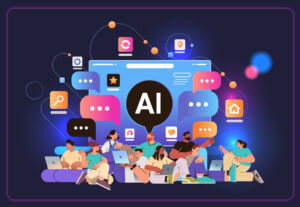Vested CEO Binna Kim on the future of AI
Ragan caught up with Group Vested CEO Binna Kim at the company’s Summer of AI event.

The summer air in New York City was sweltering last week, making Vested’s Summer of AI event covering one of the hottest topics in communications all the more fitting. The networking gathering brought together some of the top communications organizations to discuss the applications of AI in communications, the arts, and society.
Prominently featured were art displays from AI collaborative artist Claire Silver, a live AI model display, and a book signing with the author of “AI@Work: How Artificial Intelligence Is Changing the Way We Work,” Dr. Bobbe Baggio.
During the event, Ragan spoke with Group Vested CEO Binna Kim on a wide range of topics in the AI space, including where she thought AI might be headed in the near future and the implications of generative AI on intellectual property.
AI and the comms implications
From an external standpoint, AI has the potential to reshape the way that customers interact with brands and stands to create new tools for communicators to share their stories. She also said that AI has some powerful potential for internal communicators as well, pointing to its ability to sift through large amounts of data quickly.
“There’s lots of potential,” Kim said. “For instance, there are tons of policies and benefits that agencies run for their employees, and let’s say an employee has a question about what those might be. “An organization could set up a generative AI tool that allows the employee to ask questions and get those answers immediately. That has huge ramifications for employee engagement going forward.”
AI conversations on the horizon
What’s something about AI that communicators aren’t discussing as much as perhaps they should be right now?
Kim mentions AI’s impacts on the economic models of communications agencies, and the transparency that surrounds AI technology, as conversations that have begun but need to evolve more in the future.
“As is typical with any technology, tech drives down the cost of labor,” Kim said. “Clients might then ask the agency what AI will have to do with the costs of an agency’s services, especially if a service becomes automated. I think this will spark a discussion about the transparency surrounding what agencies are using AI for in their work.”
Rights and usage
One of the big elephants in the room when it comes to AI centers on just who owns what a generative program spits back out to the user. Who owns it? The data to create generated responses must come from somewhere, but where is the line? This is particularly applicable when it comes to image-based AI platforms such as DALL-E.
According to Kim, there isn’t a clear answer right now, but it bears watching going forward.
“I don’t think anyone has the answer just yet,” Kim said. “But ownership of your own image and brand is huge. Whether it’s platforms like DALL-E and others and it creates images, who ultimately owns the final product? Even for news organizations, if ChatGPT can scrape information and spit it back to an end user, who owns the information?”
She went on to say that further conversations on how we govern the use of AI in the future are needed.
“I think there are things that need to be put into place like guardrails, governance, and regulation, but it’s still early days.”
Sean Devlin is an editor at Ragan Communications. In his spare time he enjoys Philly sports, a good pint and ’90s trivia night.







